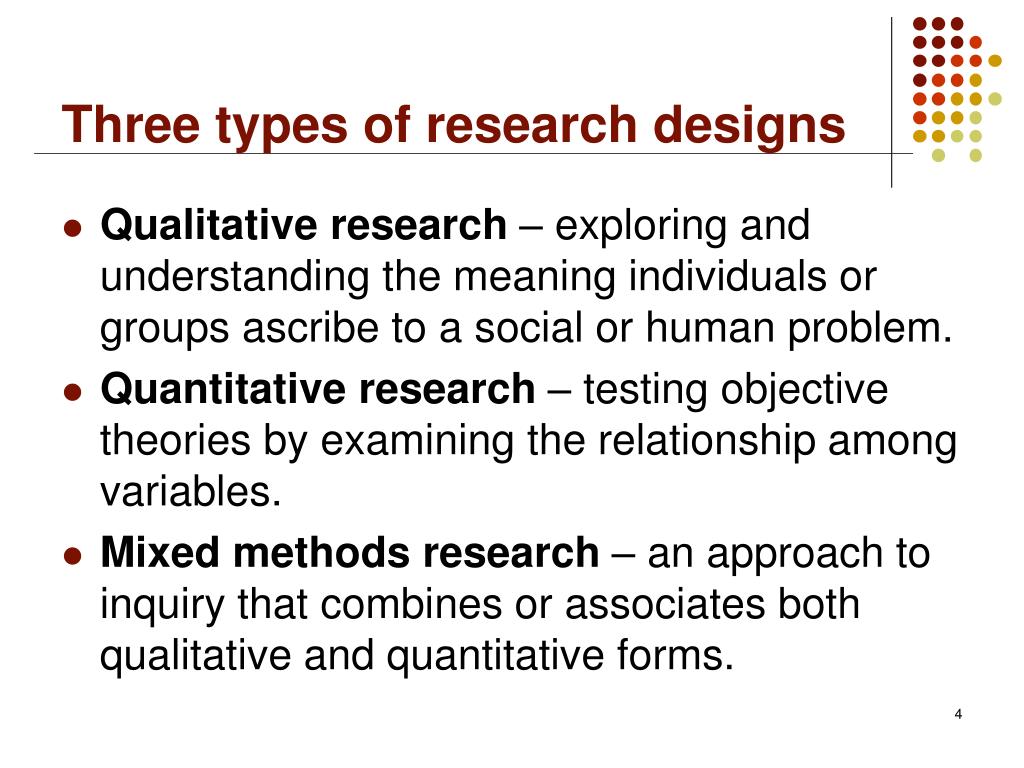Descriptive Research Design Types, Methods and Examples
Table Of Content

This would involve diving deeply into the organisation to explore and understand what makes it tick – from marketing to HR to finance. In terms of data collection, this could include interviews with staff and management, review of policy documents and financial statements, surveying customers, etc. With case study research design, you, as the researcher, investigate a single individual (or a single group of individuals) to gain an in-depth understanding of their experiences, behaviours or outcomes. The key defining attribute of this type of research design is that it purely describes the situation.

Measuring change over time
The document that contains information about the technique, methods and essential details of a project is called a research design. A detailed plan will give your research direction, sharpen your research methods and set your study up for success. This detailed plan is referred to as research design in the professional realm. Several studies also have shown that asking a more specific question before a more general question (e.g., asking about happiness with one’s marriage before asking about one’s overall happiness) can result in a contrast effect. Although some exceptions have been found, people tend to avoid redundancy by excluding the more specific question from the general rating. An example of a contrast effect can be seen in a Pew Research Center poll conducted in October 2003, a dozen years before same-sex marriage was legalized in the U.S.
What is Research Design? Understand Types of Research Design, with Examples
Research can also be classified as quantitative or qualitative at a higher level. When you conduct research, you need to have a clear idea of what you want to achieve and how to accomplish it. A good research design enables you to collect accurate and reliable data to draw valid conclusions. The purpose of a historical research design is to collect, verify, and synthesize evidence from the past to establish facts that defend or refute a hypothesis. It uses secondary sources and a variety of primary documentary evidence, such as, diaries, official records, reports, archives, and non-textual information [maps, pictures, audio and visual recordings].
Grounded Theory
Modifying the context of the question could call into question any observed changes over time (see measuring change over time for more information). In general, questions that use simple and concrete language are more easily understood by respondents. It is especially important to consider the education level of the survey population when thinking about how easy it will be for respondents to interpret and answer a question.
Organizing Academic Research Papers: Types of Research Designs
However, their controlled conditions may not always reflect how things work in the real world. Qualitative research designs tend to be more flexible and inductive, allowing you to adjust your approach based on what you find throughout the research process. You might have to write up a research design as a standalone assignment, or it might be part of a larger research proposal or other project. In either case, you should carefully consider which methods are most appropriate and feasible for answering your question. Navigating the world of research can be daunting, especially if you’re a first-time researcher.
Qualitative longitudinal research in health research: a method study - BMC Medical Research Methodology - BMC Medical Research Methodology
Qualitative longitudinal research in health research: a method study - BMC Medical Research Methodology.
Posted: Sat, 01 Oct 2022 07:00:00 GMT [source]
Directionality of study designs
Research Design- Meaning, Elements, And Types - The Good Men Project
Research Design- Meaning, Elements, And Types.
Posted: Wed, 15 Feb 2023 08:00:00 GMT [source]
A cross-sectional design surveys different people in the same population at multiple points in time. However, it is common for the set of people in survey panels to change over time as new panelists are added and some prior panelists drop out. Many of the questions in Pew Research Center surveys have been asked in prior polls. Questionnaire design is a multistage process that requires attention to many details at once.
Top 16 Research Design Methods
Research design is the process of planning and executing a study to answer specific questions. This process allows you to test hypotheses in the business or scientific fields. A case study is an in-depth study of a particular research problem rather than a sweeping statistical survey or comprehensive comparative inquiry. Research study design is a framework, or the set of methods and procedures used to collect and analyze data on variables specified in a particular research problem.
Descriptive design is a theory-based research method describing the research’s primary subject matter. This type of research design uses data collection techniques like natural observation, case studies, and surveys to derive results.This type of research design provides insight into the why and how of research. Once the survey questions are developed, particular attention should be paid to how they are ordered in the questionnaire.
Since the design of a study can affect the validity of its results, it is important to understand the different types of study designs and their strengths and limitations. Researchers analyze textual, visual, or audio data to identify patterns, themes, and trends. As you can see, a case study research design is particularly useful where a deep and contextualised understanding of a specific phenomenon or issue is desired. In other words, you can’t generalise the findings from a case study to the broader population.
However, it also means you don’t have any control over which variables to measure or how to measure them, so the conclusions you can draw may be limited. There are many other ways you might collect data depending on your field and topic. In these types of design, you still have to carefully consider your choice of case or community. You should have a clear rationale for why this particular case is suitable for answering your research question.
Capture snapshots of reality with Cross-Sectional Studies, unraveling intricate relationships and disparities between variables in a single moment. Embark on longitudinal journeys with Longitudinal Studies, tracking evolving trends and patterns over time. Delve into the heart of experimentation with Randomized Controlled Trials (RCTs). By randomizing participants into experimental and control groups, RCTs meticulously assess the efficacy of interventions or treatments, establishing clear cause-and-effect relationships. Before collecting data, it’s important to consider how you will operationalise the variables that you want to measure. Your choice of statistical test depends on various aspects of your research design, including the types of variables you’re dealing with and the distribution of your data.
If there is evidence suggesting that a change in a trend stems from switching from phone to online measurement, Center reports flag that possibility for readers to try to head off confusion or erroneous conclusions. Surveyors may conduct pilot tests or focus groups in the early stages of questionnaire development in order to better understand how people think about an issue or comprehend a question. Pretesting a survey is an essential step in the questionnaire design process to evaluate how people respond to the overall questionnaire and specific questions, especially when questions are being introduced for the first time.
This often results in smaller sample sizes, which can reduce the statistical power and generalisability of the results. Cohort studies resemble clinical trials except that the exposure is naturally determined instead of being decided by the investigator. Here, the direction of enquiry begins with the exposure and then proceeds to outcome.
With this type of research design, you, as the researcher, manipulate one variable (the independent variable) while controlling others (dependent variables). Doing so allows you to observe the effect of the former on the latter and draw conclusions about potential causality. For example, if you wanted to explore the relationship between exercise frequency and overall health, you could use a correlational design to help you achieve this. In this case, you might gather data on participants’ exercise habits, as well as records of their health indicators like blood pressure, heart rate, or body mass index.
Comments
Post a Comment